Flight Centre Report: Critical Analysis of Financial Reporting
VerifiedAdded on 2023/06/13
|9
|2140
|459
Report
AI Summary
This report provides a critical analysis of Flight Centre's financial reporting, evaluating its effectiveness in meeting the obligations of the conceptual framework of accounting. It addresses key questions such as whether Flight Centre has met the objectives of General Purpose Financial Reporting, whether the target audience can adequately use the reports, and whether the company has satisfied the recognition criteria for the elements of financial statements. The analysis further examines if Flight Centre has exhibited fundamental and enhancing qualitative characteristics of financial reporting, ensuring relevance, faithful representation, verifiability, understandability, comparability, and timeliness. The report concludes that Flight Centre has largely satisfied these criteria, providing transparent and reliable financial information to its stakeholders.

Flight Centre Analysis 1
FLIGHT CENTRE ANALYSIS
Author’s Name
Course
Lecturer
Institution
Date
FLIGHT CENTRE ANALYSIS
Author’s Name
Course
Lecturer
Institution
Date
Paraphrase This Document
Need a fresh take? Get an instant paraphrase of this document with our AI Paraphraser
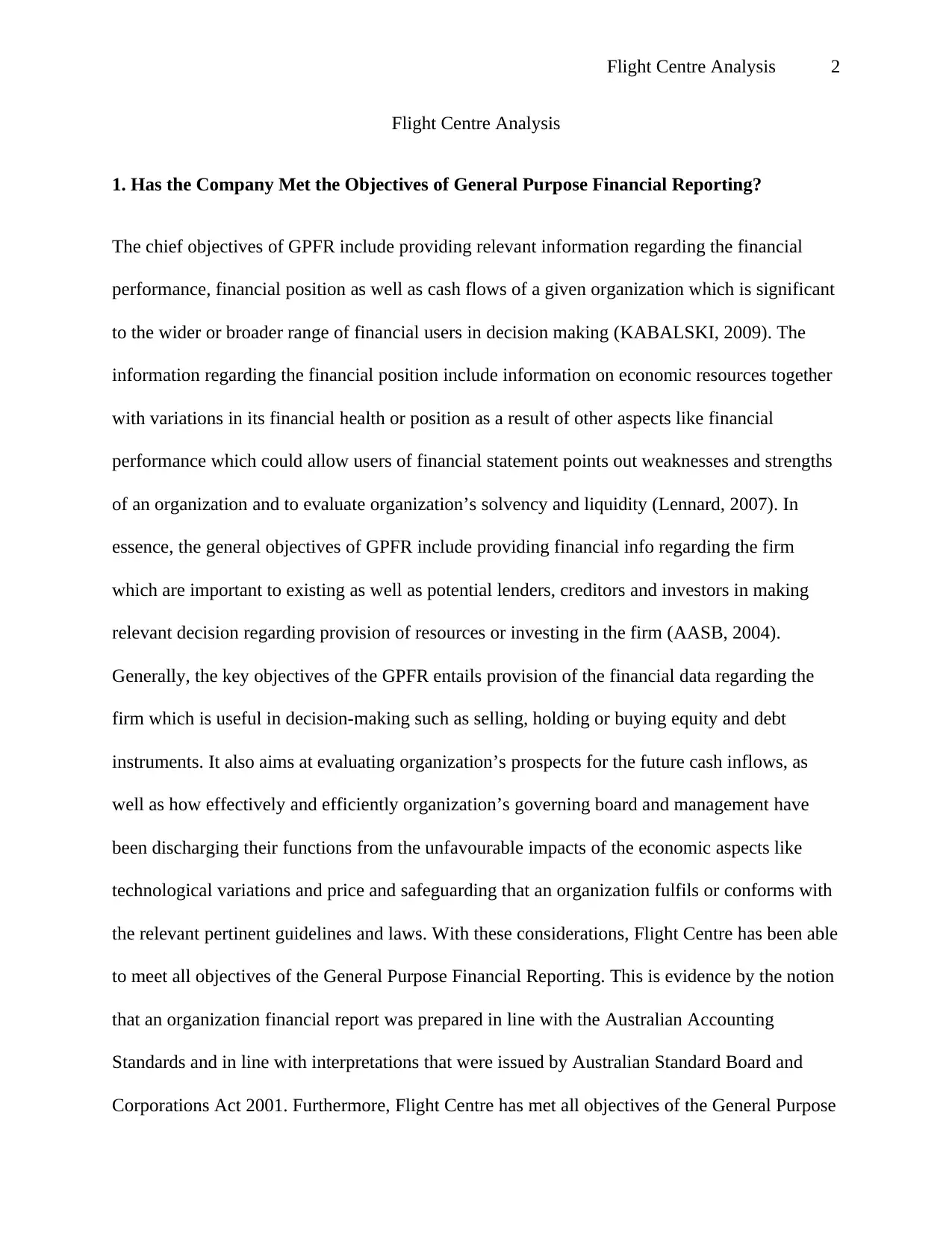
Flight Centre Analysis 2
Flight Centre Analysis
1. Has the Company Met the Objectives of General Purpose Financial Reporting?
The chief objectives of GPFR include providing relevant information regarding the financial
performance, financial position as well as cash flows of a given organization which is significant
to the wider or broader range of financial users in decision making (KABALSKI, 2009). The
information regarding the financial position include information on economic resources together
with variations in its financial health or position as a result of other aspects like financial
performance which could allow users of financial statement points out weaknesses and strengths
of an organization and to evaluate organization’s solvency and liquidity (Lennard, 2007). In
essence, the general objectives of GPFR include providing financial info regarding the firm
which are important to existing as well as potential lenders, creditors and investors in making
relevant decision regarding provision of resources or investing in the firm (AASB, 2004).
Generally, the key objectives of the GPFR entails provision of the financial data regarding the
firm which is useful in decision-making such as selling, holding or buying equity and debt
instruments. It also aims at evaluating organization’s prospects for the future cash inflows, as
well as how effectively and efficiently organization’s governing board and management have
been discharging their functions from the unfavourable impacts of the economic aspects like
technological variations and price and safeguarding that an organization fulfils or conforms with
the relevant pertinent guidelines and laws. With these considerations, Flight Centre has been able
to meet all objectives of the General Purpose Financial Reporting. This is evidence by the notion
that an organization financial report was prepared in line with the Australian Accounting
Standards and in line with interpretations that were issued by Australian Standard Board and
Corporations Act 2001. Furthermore, Flight Centre has met all objectives of the General Purpose
Flight Centre Analysis
1. Has the Company Met the Objectives of General Purpose Financial Reporting?
The chief objectives of GPFR include providing relevant information regarding the financial
performance, financial position as well as cash flows of a given organization which is significant
to the wider or broader range of financial users in decision making (KABALSKI, 2009). The
information regarding the financial position include information on economic resources together
with variations in its financial health or position as a result of other aspects like financial
performance which could allow users of financial statement points out weaknesses and strengths
of an organization and to evaluate organization’s solvency and liquidity (Lennard, 2007). In
essence, the general objectives of GPFR include providing financial info regarding the firm
which are important to existing as well as potential lenders, creditors and investors in making
relevant decision regarding provision of resources or investing in the firm (AASB, 2004).
Generally, the key objectives of the GPFR entails provision of the financial data regarding the
firm which is useful in decision-making such as selling, holding or buying equity and debt
instruments. It also aims at evaluating organization’s prospects for the future cash inflows, as
well as how effectively and efficiently organization’s governing board and management have
been discharging their functions from the unfavourable impacts of the economic aspects like
technological variations and price and safeguarding that an organization fulfils or conforms with
the relevant pertinent guidelines and laws. With these considerations, Flight Centre has been able
to meet all objectives of the General Purpose Financial Reporting. This is evidence by the notion
that an organization financial report was prepared in line with the Australian Accounting
Standards and in line with interpretations that were issued by Australian Standard Board and
Corporations Act 2001. Furthermore, Flight Centre has met all objectives of the General Purpose
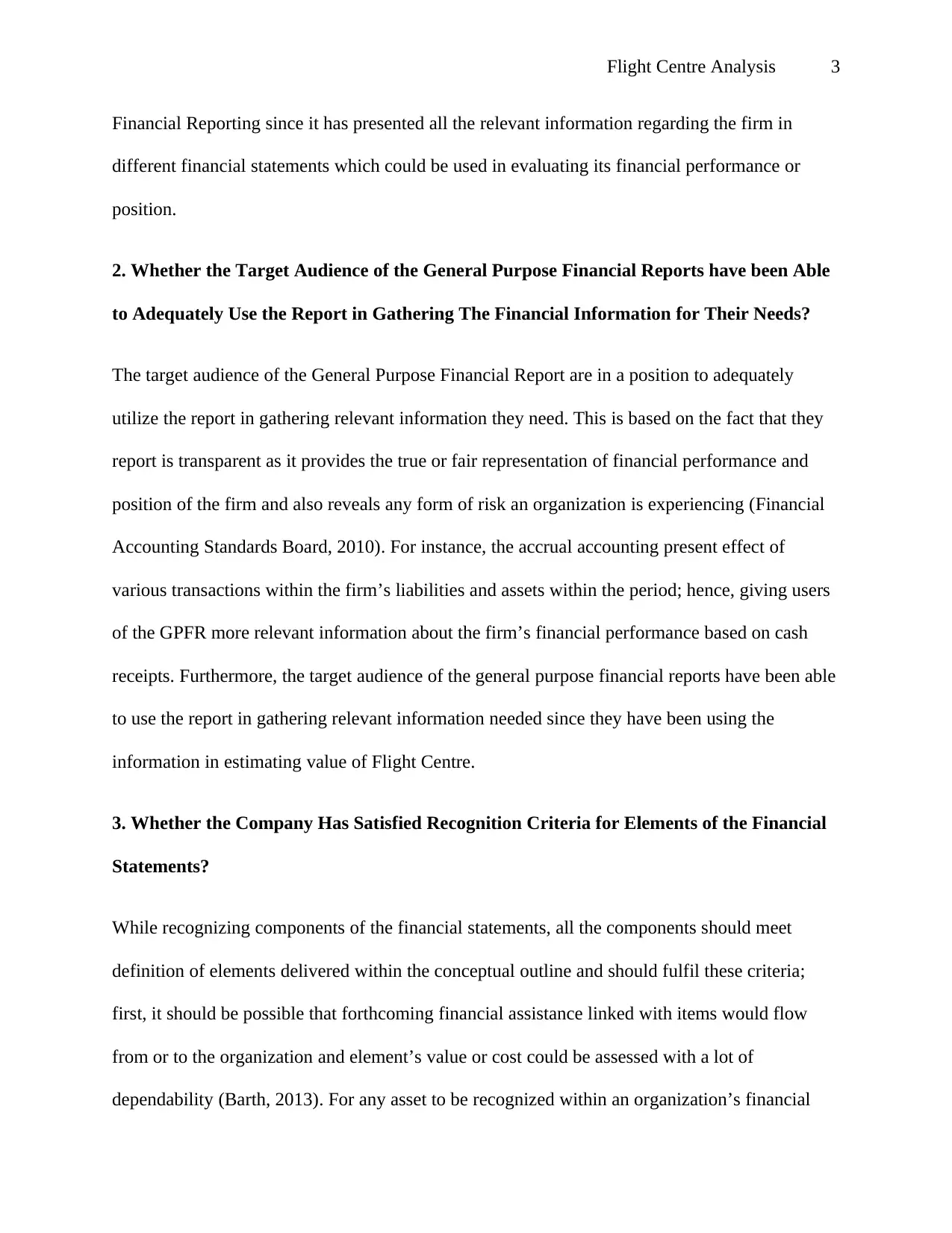
Flight Centre Analysis 3
Financial Reporting since it has presented all the relevant information regarding the firm in
different financial statements which could be used in evaluating its financial performance or
position.
2. Whether the Target Audience of the General Purpose Financial Reports have been Able
to Adequately Use the Report in Gathering The Financial Information for Their Needs?
The target audience of the General Purpose Financial Report are in a position to adequately
utilize the report in gathering relevant information they need. This is based on the fact that they
report is transparent as it provides the true or fair representation of financial performance and
position of the firm and also reveals any form of risk an organization is experiencing (Financial
Accounting Standards Board, 2010). For instance, the accrual accounting present effect of
various transactions within the firm’s liabilities and assets within the period; hence, giving users
of the GPFR more relevant information about the firm’s financial performance based on cash
receipts. Furthermore, the target audience of the general purpose financial reports have been able
to use the report in gathering relevant information needed since they have been using the
information in estimating value of Flight Centre.
3. Whether the Company Has Satisfied Recognition Criteria for Elements of the Financial
Statements?
While recognizing components of the financial statements, all the components should meet
definition of elements delivered within the conceptual outline and should fulfil these criteria;
first, it should be possible that forthcoming financial assistance linked with items would flow
from or to the organization and element’s value or cost could be assessed with a lot of
dependability (Barth, 2013). For any asset to be recognized within an organization’s financial
Financial Reporting since it has presented all the relevant information regarding the firm in
different financial statements which could be used in evaluating its financial performance or
position.
2. Whether the Target Audience of the General Purpose Financial Reports have been Able
to Adequately Use the Report in Gathering The Financial Information for Their Needs?
The target audience of the General Purpose Financial Report are in a position to adequately
utilize the report in gathering relevant information they need. This is based on the fact that they
report is transparent as it provides the true or fair representation of financial performance and
position of the firm and also reveals any form of risk an organization is experiencing (Financial
Accounting Standards Board, 2010). For instance, the accrual accounting present effect of
various transactions within the firm’s liabilities and assets within the period; hence, giving users
of the GPFR more relevant information about the firm’s financial performance based on cash
receipts. Furthermore, the target audience of the general purpose financial reports have been able
to use the report in gathering relevant information needed since they have been using the
information in estimating value of Flight Centre.
3. Whether the Company Has Satisfied Recognition Criteria for Elements of the Financial
Statements?
While recognizing components of the financial statements, all the components should meet
definition of elements delivered within the conceptual outline and should fulfil these criteria;
first, it should be possible that forthcoming financial assistance linked with items would flow
from or to the organization and element’s value or cost could be assessed with a lot of
dependability (Barth, 2013). For any asset to be recognized within an organization’s financial
⊘ This is a preview!⊘
Do you want full access?
Subscribe today to unlock all pages.

Trusted by 1+ million students worldwide

Flight Centre Analysis 4
statements, it should be done even if ownership belongs to a different person. In essence, an asset
is only recognized if benefits from its sale or use are likely. In addition, assets should be
recognized if the figures presented in the financial statement could be objectively measured.
Proper recognition criteria rely on numerous principles and assumptions which underlie financial
reporting process of any firm. In this case, Flight Centre has satisfied all the recognition criteria
for all components within an organization’s financial report. This is mostly due to the notion that
it recognized assets in its balance sheet knowing that it is possible that upcoming financial
benefit would run to its and assets had value or cost which could be measured in a reliable
manner. Furthermore, the firm recognized its liability within its balance sheet where it was
possible that expenditure would result from settlement of present obligations. For instance, its
account payable presented current obligations which in turn resulted in outflow of the resources
embodying the economic benefits. Additionally, recognition of the expenses in Flight Centre
occurred concurrently with the recognition of decrease in its assets or increase in its liabilities.
For instance, depreciation of the asset decrease and expenses was recognized. Furthermore,
given that income is usually recognized in an organization’s income statement whenever there is
an upsurge in the forthcoming financial paybacks linked with upsurge in its assets or reduction in
its liabilities which could be measured reliably, it is evident that Fight Centre observed and
satisfied recognition criteria of all elements of the financial statement and in particular
recognition criteria of income since it recognized income concurrently with the recognition of
decrease in its liabilities or increase in its assets.
4. Whether the Company Has Exhibited Fundamental Qualitative Characteristics of the
Financial Reporting?
statements, it should be done even if ownership belongs to a different person. In essence, an asset
is only recognized if benefits from its sale or use are likely. In addition, assets should be
recognized if the figures presented in the financial statement could be objectively measured.
Proper recognition criteria rely on numerous principles and assumptions which underlie financial
reporting process of any firm. In this case, Flight Centre has satisfied all the recognition criteria
for all components within an organization’s financial report. This is mostly due to the notion that
it recognized assets in its balance sheet knowing that it is possible that upcoming financial
benefit would run to its and assets had value or cost which could be measured in a reliable
manner. Furthermore, the firm recognized its liability within its balance sheet where it was
possible that expenditure would result from settlement of present obligations. For instance, its
account payable presented current obligations which in turn resulted in outflow of the resources
embodying the economic benefits. Additionally, recognition of the expenses in Flight Centre
occurred concurrently with the recognition of decrease in its assets or increase in its liabilities.
For instance, depreciation of the asset decrease and expenses was recognized. Furthermore,
given that income is usually recognized in an organization’s income statement whenever there is
an upsurge in the forthcoming financial paybacks linked with upsurge in its assets or reduction in
its liabilities which could be measured reliably, it is evident that Fight Centre observed and
satisfied recognition criteria of all elements of the financial statement and in particular
recognition criteria of income since it recognized income concurrently with the recognition of
decrease in its liabilities or increase in its assets.
4. Whether the Company Has Exhibited Fundamental Qualitative Characteristics of the
Financial Reporting?
Paraphrase This Document
Need a fresh take? Get an instant paraphrase of this document with our AI Paraphraser
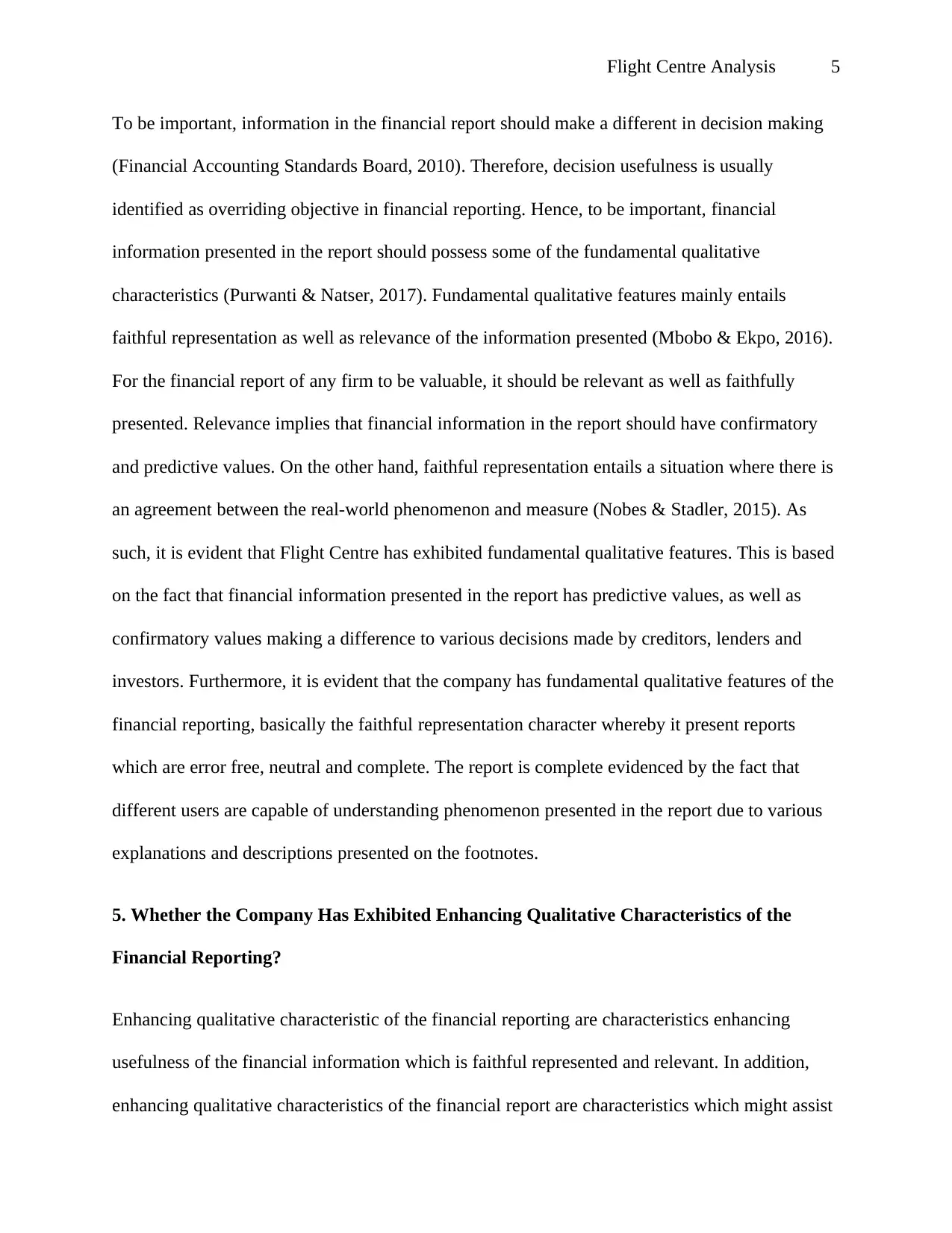
Flight Centre Analysis 5
To be important, information in the financial report should make a different in decision making
(Financial Accounting Standards Board, 2010). Therefore, decision usefulness is usually
identified as overriding objective in financial reporting. Hence, to be important, financial
information presented in the report should possess some of the fundamental qualitative
characteristics (Purwanti & Natser, 2017). Fundamental qualitative features mainly entails
faithful representation as well as relevance of the information presented (Mbobo & Ekpo, 2016).
For the financial report of any firm to be valuable, it should be relevant as well as faithfully
presented. Relevance implies that financial information in the report should have confirmatory
and predictive values. On the other hand, faithful representation entails a situation where there is
an agreement between the real-world phenomenon and measure (Nobes & Stadler, 2015). As
such, it is evident that Flight Centre has exhibited fundamental qualitative features. This is based
on the fact that financial information presented in the report has predictive values, as well as
confirmatory values making a difference to various decisions made by creditors, lenders and
investors. Furthermore, it is evident that the company has fundamental qualitative features of the
financial reporting, basically the faithful representation character whereby it present reports
which are error free, neutral and complete. The report is complete evidenced by the fact that
different users are capable of understanding phenomenon presented in the report due to various
explanations and descriptions presented on the footnotes.
5. Whether the Company Has Exhibited Enhancing Qualitative Characteristics of the
Financial Reporting?
Enhancing qualitative characteristic of the financial reporting are characteristics enhancing
usefulness of the financial information which is faithful represented and relevant. In addition,
enhancing qualitative characteristics of the financial report are characteristics which might assist
To be important, information in the financial report should make a different in decision making
(Financial Accounting Standards Board, 2010). Therefore, decision usefulness is usually
identified as overriding objective in financial reporting. Hence, to be important, financial
information presented in the report should possess some of the fundamental qualitative
characteristics (Purwanti & Natser, 2017). Fundamental qualitative features mainly entails
faithful representation as well as relevance of the information presented (Mbobo & Ekpo, 2016).
For the financial report of any firm to be valuable, it should be relevant as well as faithfully
presented. Relevance implies that financial information in the report should have confirmatory
and predictive values. On the other hand, faithful representation entails a situation where there is
an agreement between the real-world phenomenon and measure (Nobes & Stadler, 2015). As
such, it is evident that Flight Centre has exhibited fundamental qualitative features. This is based
on the fact that financial information presented in the report has predictive values, as well as
confirmatory values making a difference to various decisions made by creditors, lenders and
investors. Furthermore, it is evident that the company has fundamental qualitative features of the
financial reporting, basically the faithful representation character whereby it present reports
which are error free, neutral and complete. The report is complete evidenced by the fact that
different users are capable of understanding phenomenon presented in the report due to various
explanations and descriptions presented on the footnotes.
5. Whether the Company Has Exhibited Enhancing Qualitative Characteristics of the
Financial Reporting?
Enhancing qualitative characteristic of the financial reporting are characteristics enhancing
usefulness of the financial information which is faithful represented and relevant. In addition,
enhancing qualitative characteristics of the financial report are characteristics which might assist
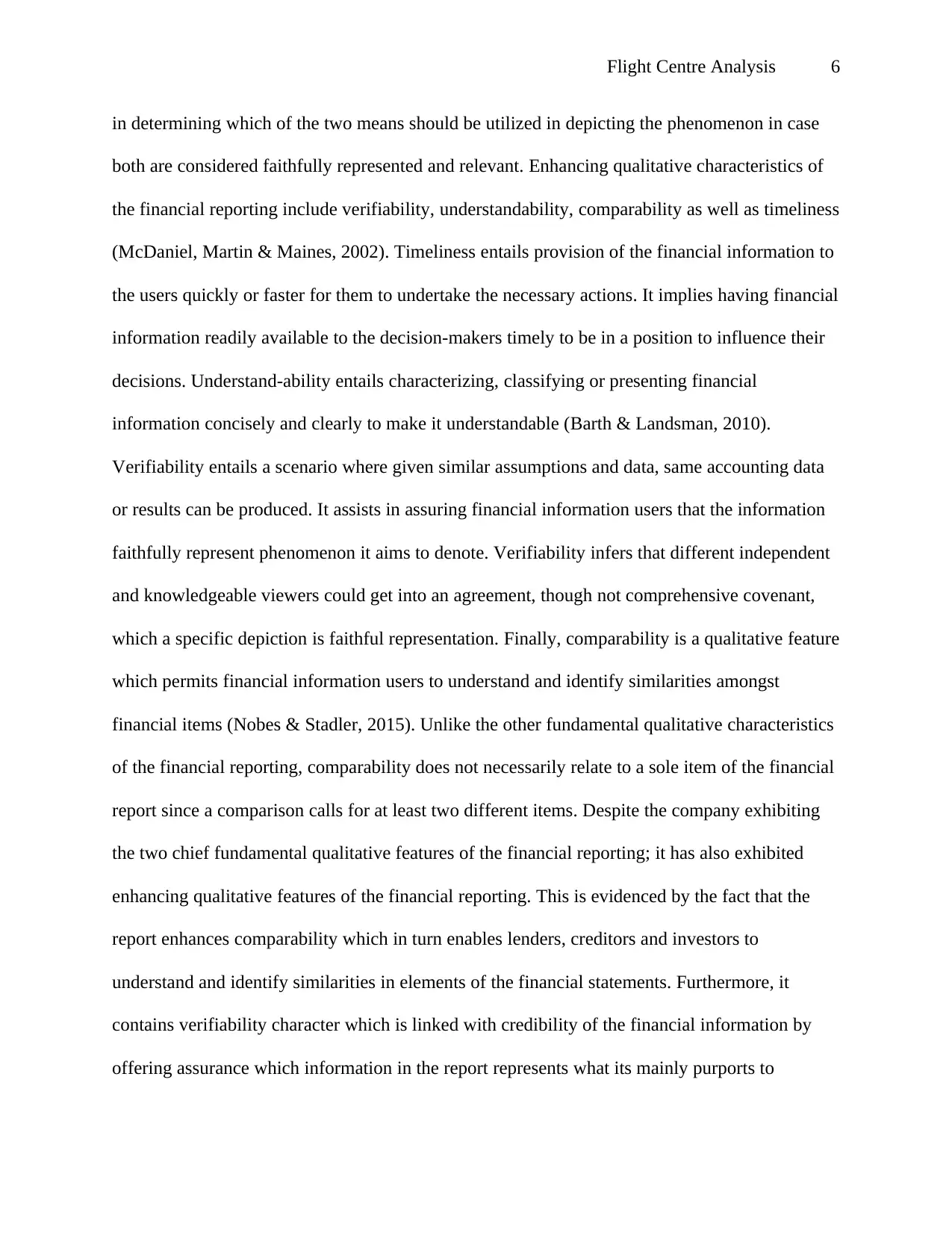
Flight Centre Analysis 6
in determining which of the two means should be utilized in depicting the phenomenon in case
both are considered faithfully represented and relevant. Enhancing qualitative characteristics of
the financial reporting include verifiability, understandability, comparability as well as timeliness
(McDaniel, Martin & Maines, 2002). Timeliness entails provision of the financial information to
the users quickly or faster for them to undertake the necessary actions. It implies having financial
information readily available to the decision-makers timely to be in a position to influence their
decisions. Understand-ability entails characterizing, classifying or presenting financial
information concisely and clearly to make it understandable (Barth & Landsman, 2010).
Verifiability entails a scenario where given similar assumptions and data, same accounting data
or results can be produced. It assists in assuring financial information users that the information
faithfully represent phenomenon it aims to denote. Verifiability infers that different independent
and knowledgeable viewers could get into an agreement, though not comprehensive covenant,
which a specific depiction is faithful representation. Finally, comparability is a qualitative feature
which permits financial information users to understand and identify similarities amongst
financial items (Nobes & Stadler, 2015). Unlike the other fundamental qualitative characteristics
of the financial reporting, comparability does not necessarily relate to a sole item of the financial
report since a comparison calls for at least two different items. Despite the company exhibiting
the two chief fundamental qualitative features of the financial reporting; it has also exhibited
enhancing qualitative features of the financial reporting. This is evidenced by the fact that the
report enhances comparability which in turn enables lenders, creditors and investors to
understand and identify similarities in elements of the financial statements. Furthermore, it
contains verifiability character which is linked with credibility of the financial information by
offering assurance which information in the report represents what its mainly purports to
in determining which of the two means should be utilized in depicting the phenomenon in case
both are considered faithfully represented and relevant. Enhancing qualitative characteristics of
the financial reporting include verifiability, understandability, comparability as well as timeliness
(McDaniel, Martin & Maines, 2002). Timeliness entails provision of the financial information to
the users quickly or faster for them to undertake the necessary actions. It implies having financial
information readily available to the decision-makers timely to be in a position to influence their
decisions. Understand-ability entails characterizing, classifying or presenting financial
information concisely and clearly to make it understandable (Barth & Landsman, 2010).
Verifiability entails a scenario where given similar assumptions and data, same accounting data
or results can be produced. It assists in assuring financial information users that the information
faithfully represent phenomenon it aims to denote. Verifiability infers that different independent
and knowledgeable viewers could get into an agreement, though not comprehensive covenant,
which a specific depiction is faithful representation. Finally, comparability is a qualitative feature
which permits financial information users to understand and identify similarities amongst
financial items (Nobes & Stadler, 2015). Unlike the other fundamental qualitative characteristics
of the financial reporting, comparability does not necessarily relate to a sole item of the financial
report since a comparison calls for at least two different items. Despite the company exhibiting
the two chief fundamental qualitative features of the financial reporting; it has also exhibited
enhancing qualitative features of the financial reporting. This is evidenced by the fact that the
report enhances comparability which in turn enables lenders, creditors and investors to
understand and identify similarities in elements of the financial statements. Furthermore, it
contains verifiability character which is linked with credibility of the financial information by
offering assurance which information in the report represents what its mainly purports to
⊘ This is a preview!⊘
Do you want full access?
Subscribe today to unlock all pages.

Trusted by 1+ million students worldwide
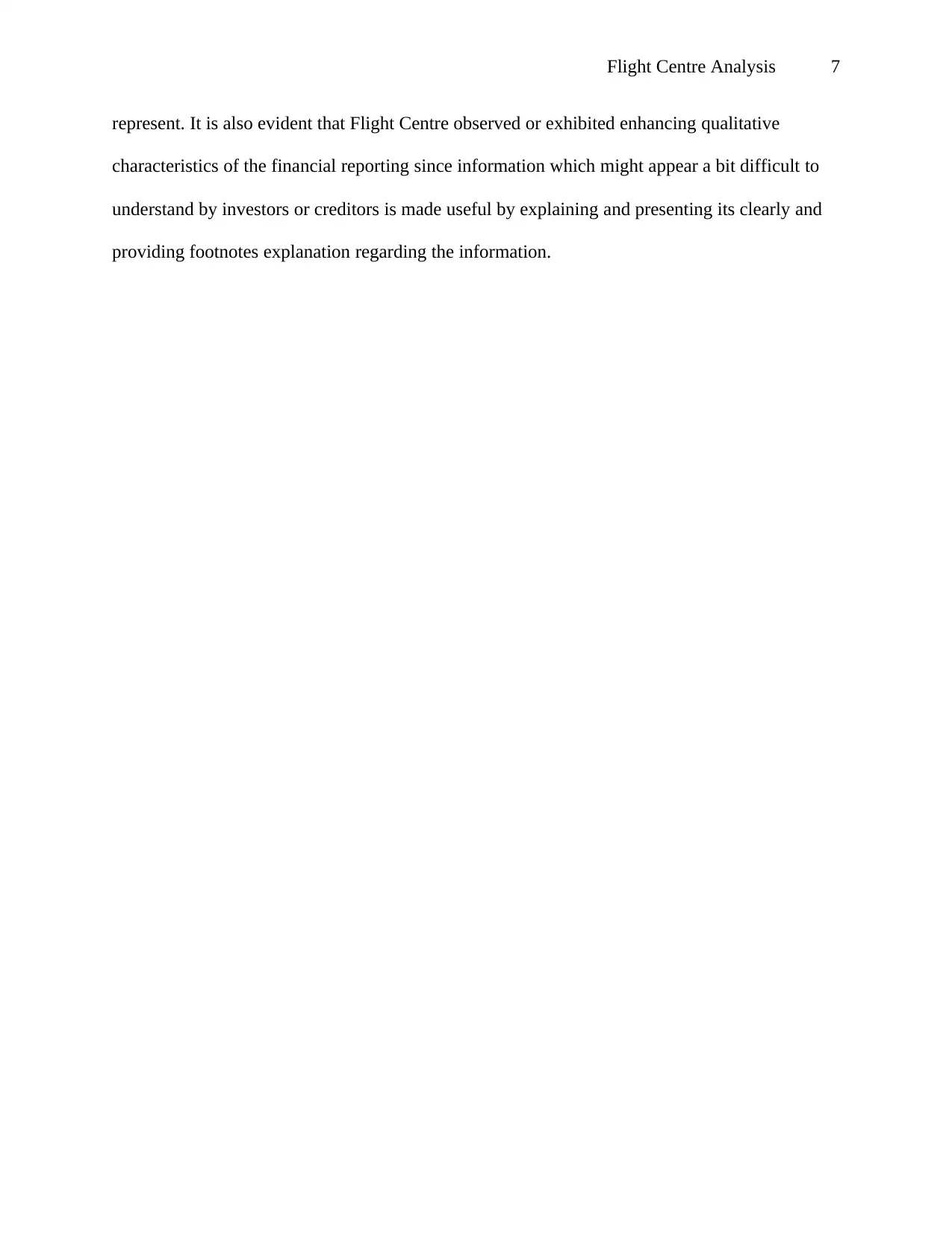
Flight Centre Analysis 7
represent. It is also evident that Flight Centre observed or exhibited enhancing qualitative
characteristics of the financial reporting since information which might appear a bit difficult to
understand by investors or creditors is made useful by explaining and presenting its clearly and
providing footnotes explanation regarding the information.
represent. It is also evident that Flight Centre observed or exhibited enhancing qualitative
characteristics of the financial reporting since information which might appear a bit difficult to
understand by investors or creditors is made useful by explaining and presenting its clearly and
providing footnotes explanation regarding the information.
Paraphrase This Document
Need a fresh take? Get an instant paraphrase of this document with our AI Paraphraser
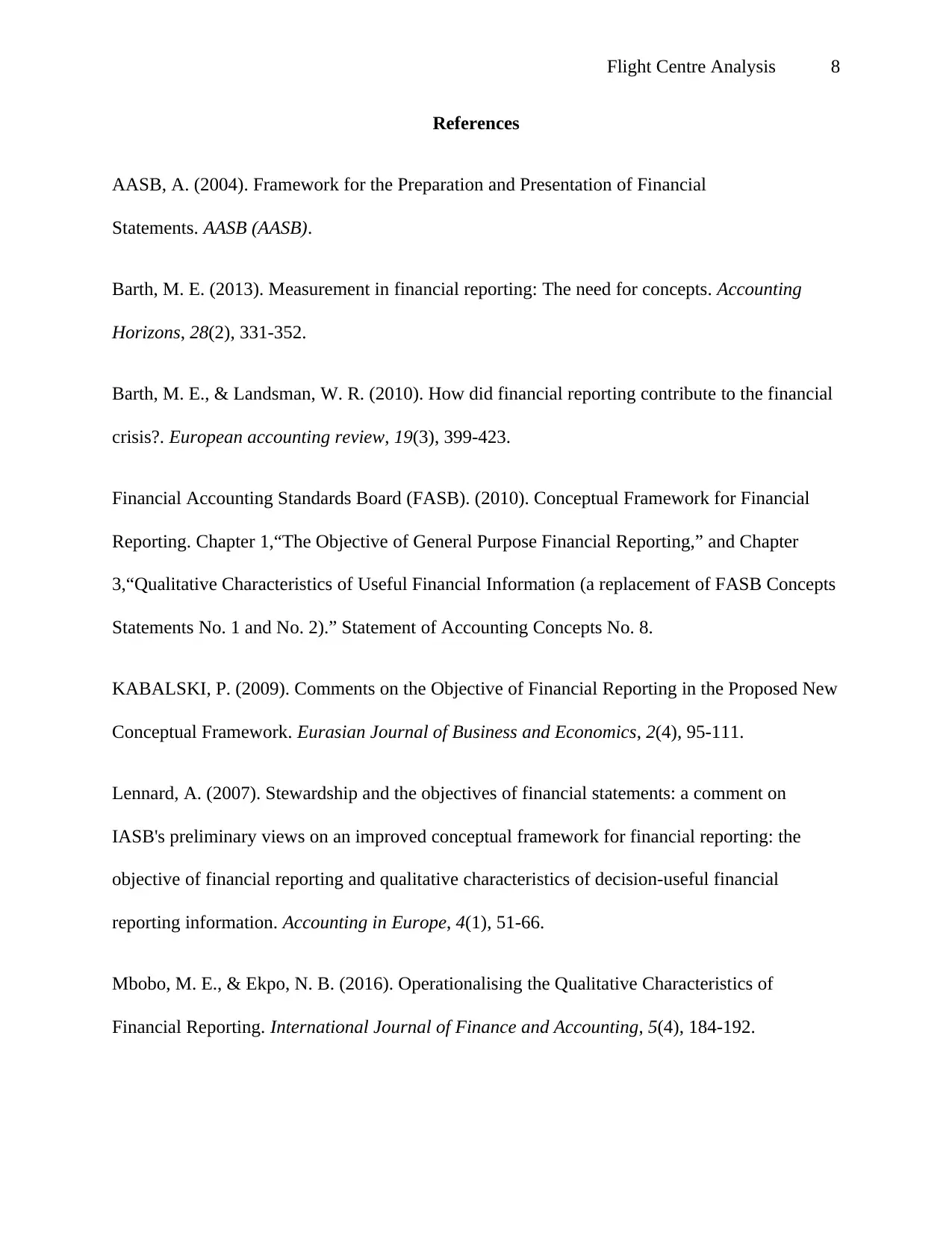
Flight Centre Analysis 8
References
AASB, A. (2004). Framework for the Preparation and Presentation of Financial
Statements. AASB (AASB).
Barth, M. E. (2013). Measurement in financial reporting: The need for concepts. Accounting
Horizons, 28(2), 331-352.
Barth, M. E., & Landsman, W. R. (2010). How did financial reporting contribute to the financial
crisis?. European accounting review, 19(3), 399-423.
Financial Accounting Standards Board (FASB). (2010). Conceptual Framework for Financial
Reporting. Chapter 1,“The Objective of General Purpose Financial Reporting,” and Chapter
3,“Qualitative Characteristics of Useful Financial Information (a replacement of FASB Concepts
Statements No. 1 and No. 2).” Statement of Accounting Concepts No. 8.
KABALSKI, P. (2009). Comments on the Objective of Financial Reporting in the Proposed New
Conceptual Framework. Eurasian Journal of Business and Economics, 2(4), 95-111.
Lennard, A. (2007). Stewardship and the objectives of financial statements: a comment on
IASB's preliminary views on an improved conceptual framework for financial reporting: the
objective of financial reporting and qualitative characteristics of decision-useful financial
reporting information. Accounting in Europe, 4(1), 51-66.
Mbobo, M. E., & Ekpo, N. B. (2016). Operationalising the Qualitative Characteristics of
Financial Reporting. International Journal of Finance and Accounting, 5(4), 184-192.
References
AASB, A. (2004). Framework for the Preparation and Presentation of Financial
Statements. AASB (AASB).
Barth, M. E. (2013). Measurement in financial reporting: The need for concepts. Accounting
Horizons, 28(2), 331-352.
Barth, M. E., & Landsman, W. R. (2010). How did financial reporting contribute to the financial
crisis?. European accounting review, 19(3), 399-423.
Financial Accounting Standards Board (FASB). (2010). Conceptual Framework for Financial
Reporting. Chapter 1,“The Objective of General Purpose Financial Reporting,” and Chapter
3,“Qualitative Characteristics of Useful Financial Information (a replacement of FASB Concepts
Statements No. 1 and No. 2).” Statement of Accounting Concepts No. 8.
KABALSKI, P. (2009). Comments on the Objective of Financial Reporting in the Proposed New
Conceptual Framework. Eurasian Journal of Business and Economics, 2(4), 95-111.
Lennard, A. (2007). Stewardship and the objectives of financial statements: a comment on
IASB's preliminary views on an improved conceptual framework for financial reporting: the
objective of financial reporting and qualitative characteristics of decision-useful financial
reporting information. Accounting in Europe, 4(1), 51-66.
Mbobo, M. E., & Ekpo, N. B. (2016). Operationalising the Qualitative Characteristics of
Financial Reporting. International Journal of Finance and Accounting, 5(4), 184-192.
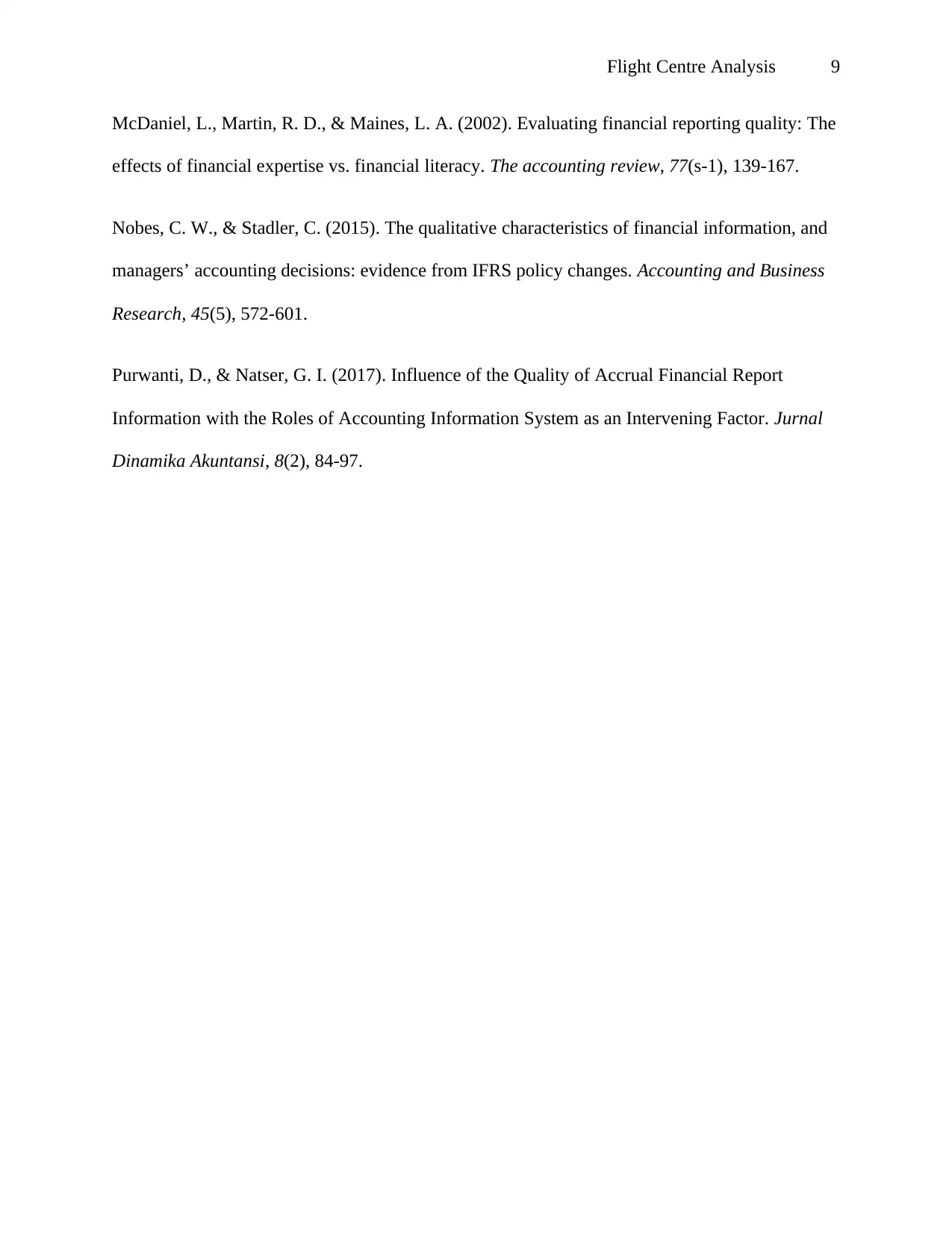
Flight Centre Analysis 9
McDaniel, L., Martin, R. D., & Maines, L. A. (2002). Evaluating financial reporting quality: The
effects of financial expertise vs. financial literacy. The accounting review, 77(s-1), 139-167.
Nobes, C. W., & Stadler, C. (2015). The qualitative characteristics of financial information, and
managers’ accounting decisions: evidence from IFRS policy changes. Accounting and Business
Research, 45(5), 572-601.
Purwanti, D., & Natser, G. I. (2017). Influence of the Quality of Accrual Financial Report
Information with the Roles of Accounting Information System as an Intervening Factor. Jurnal
Dinamika Akuntansi, 8(2), 84-97.
McDaniel, L., Martin, R. D., & Maines, L. A. (2002). Evaluating financial reporting quality: The
effects of financial expertise vs. financial literacy. The accounting review, 77(s-1), 139-167.
Nobes, C. W., & Stadler, C. (2015). The qualitative characteristics of financial information, and
managers’ accounting decisions: evidence from IFRS policy changes. Accounting and Business
Research, 45(5), 572-601.
Purwanti, D., & Natser, G. I. (2017). Influence of the Quality of Accrual Financial Report
Information with the Roles of Accounting Information System as an Intervening Factor. Jurnal
Dinamika Akuntansi, 8(2), 84-97.
⊘ This is a preview!⊘
Do you want full access?
Subscribe today to unlock all pages.

Trusted by 1+ million students worldwide
1 out of 9
Related Documents
Your All-in-One AI-Powered Toolkit for Academic Success.
+13062052269
info@desklib.com
Available 24*7 on WhatsApp / Email
![[object Object]](/_next/static/media/star-bottom.7253800d.svg)
Unlock your academic potential
Copyright © 2020–2025 A2Z Services. All Rights Reserved. Developed and managed by ZUCOL.




